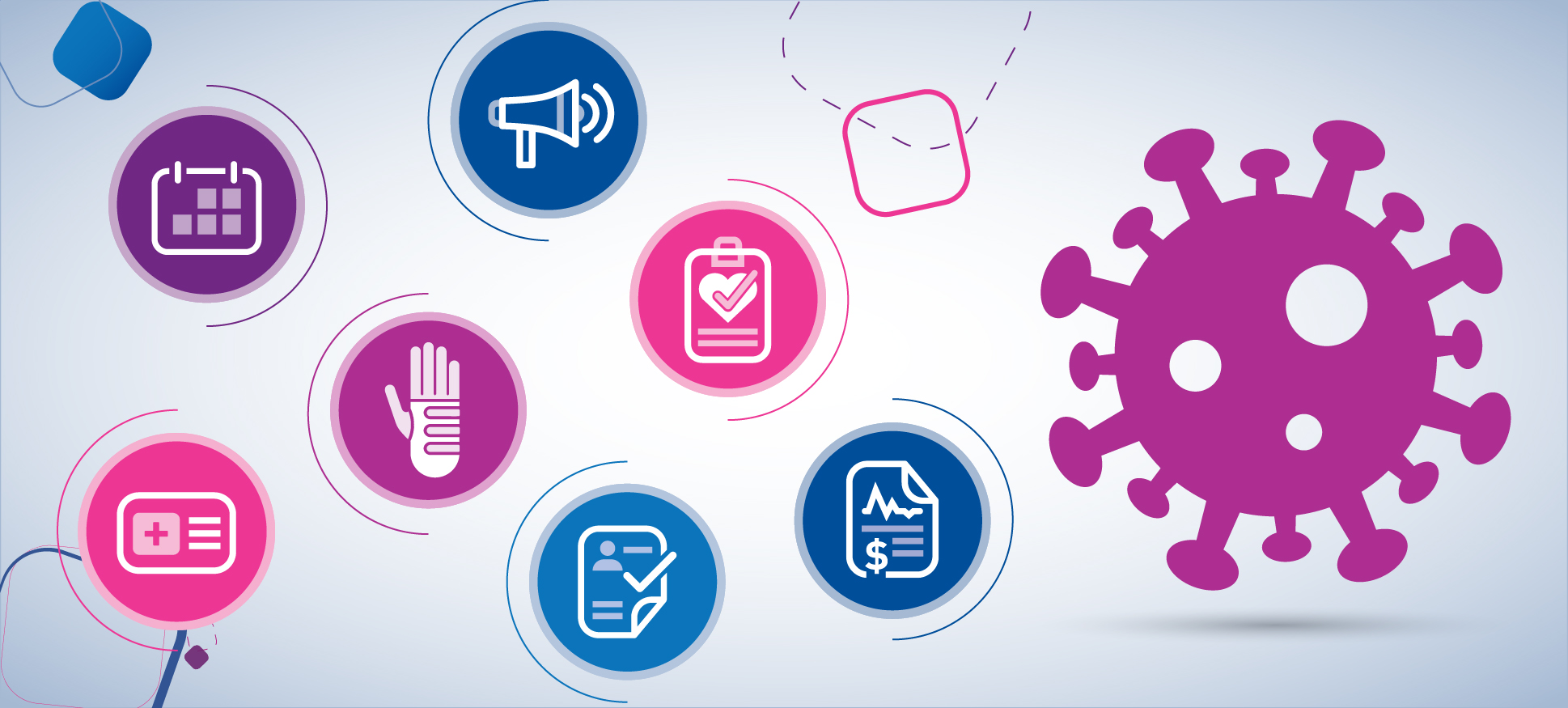Data and Analytics
Capturing the right data and turning it into actionable insights will improve revenue cycle, patient outreach, and marketing strategies.

No healthcare organization is immune to the problem of bad data. One in five patients has found errors when looking at their electronic health record (EHR). This includes incorrect information about their diagnosis, medications, test results and more. If the data held in patient records is incomplete, inconsistent, or inaccurate, this can lead to poor clinical decision-making, substandard patient experiences, and gaps in treatment or follow-up. In Experian Health’s State of Patient Access 2.0 survey, patient identity management emerged as a major challenge for healthcare providers, with almost half of the respondents saying that inaccurate and incomplete patient data hindered follow-up contacts and patient outreach. “Dirty” data also presents a major financial risk, costing healthcare organizations millions of dollars per year. Many providers have stepped up their digital offerings in the last few years, particularly in response to the pandemic. While digitalization offers huge advantages, it does have an unfortunate side effect. As more data is created, shared and accessed, there are more opportunities for mistakes. Some industries may accept a certain amount of rogue data as inevitable, but in healthcare, it mustn’t become the norm. Patient data needs to be consistent, complete and standardized to ensure the highest standards of care. The Centers for Medicare and Medicaid Services (CMS) recognizes the need for an easier and more secure exchange of healthcare data, and are taking steps to facilitate interoperability. As these provisions are finalized, providers can act now to embed data standardization in their digital services. Better data means better decisions, better care and lower costs. As the digital transformation continues, providers must implement strategies to eliminate inaccuracies, enable consistent identity management, and ensure data is standardized across all their systems and networks. In this article, we share three steps to help your organization ensure that patient data remains complete and consistent for better patient identity management. 1. Start with the right patient data As the saying goes: garbage in, garbage out. Reliable patient records require the right information to be added from the start, or errors will follow the patient throughout their healthcare journey. This will only continue compounding over time. A 2021 survey of Experian Health clients revealed that incomplete data arises for a variety of reasons. This ranges from patients not filling out forms correctly prior to their visit or forgetting their insurance cards, to staff having limited time to complete documentation. Typos, misspellings, duplicate data and missing information can also cause identity errors.* Providers should reduce the risk of inaccurate data from being added to a patient’s record in the first place. A standardized approach to data formatting is a good place to start. For example, if a patient is accustomed to writing their date of birth in a European format, with the day before the month, they may enter this incorrectly when filling out online patient access forms. Configuring calendar drop-down menus in such a way that prevents this will avoid these basic but costly errors. With a Universal Identity Manager (UIM), each patient’s record can be maintained in a standardized format. Probabilistic and referential matching techniques are used to check the patient’s identification information against existing databases, for a more complete view of the patient regardless of any data gaps. 2. Solve patient matching challenges with robust identity verification It doesn’t matter if patient records are accurate if staff pull up the wrong record when they speak to a patient. Providers should prioritize consistent identity management to ensure clinical and non-clinical staff see the same and correct information, regardless of where or when a patient interacts with their organization. Identity Verification validates the patient’s identification information during pre-registration and check-in by instantly accessing demographic information. This includes the patient’s name, address, Social Security number, date of birth, phone number and insurance coverage data. If there’s a mistake, it’s easily found and corrected. 3. Standardize data to maintain clean patient databases Victoria Dames, Vice President Identity Management at Experian Health explains why standardization is so important: “The increasing use of digital services means that more healthcare data is being exchanged within and between health systems than ever before. However, in order to leverage the opportunities that come with a more connected healthcare system, we need that data to be as reliable as possible. Preventing inaccuracies before they occur will be much more cost-effective than scrambling to fix them after the damage is done. With a standardized approach to data collection and management, healthcare organizations can maintain reliable records for every individual patient and stay ahead of the game as more data is generated and shared.” Unique Patient Identifier (UPI) helps providers eliminate duplicate records so there’s a “single source of truth” for each patient. After the UIM matches the patient’s information within a single and accurate patient file, a UPI is assigned to that record and maintained in a master index. This is far more secure than a traditional matching algorithm based on Social Security numbers, which can be vulnerable to errors. Together, these tools help healthcare providers create and maintain a “golden record” for each patient. Data quality will always be a challenge. However, with the right data standardization strategies, providers can make better decisions. This will create better patient experiences and better health outcomes while limiting the financial impact of dirty data. Contact Experian Health today to find opportunities to clean up your healthcare data for better patient identity management. *Survey of Experian Health clients, October 2021 Are you an Experian Health client? Then we invite you to join our Innovation Studio research community. Your ongoing input is key to driving improvements to our tools and products! Sign up here!

As the digital healthcare revolution takes hold, do assumptions about a generation gap still hold true? Do Millennials and Gen Z have different expectations of healthcare providers compared to Baby Boomers and Gen X? In today’s hyper-connected world, the differences are a matter of degree. We’re all Gen C now. Futurist Brian Solis coined the term “Gen C” in 2012 to describe the rise of the “connected consumer,” a generation of active participants in the digital-first economy. Recently, the term has come to be associated with everyone living through the age of COVID-19. This includes pandemic babies whose early months have been shaped by quarantines and virtual playdates, and consumers of all ages who have reimagined their lives through digital tools and services. Gen C transcends the usual generational divides. Experian Health’s State of Patient Access 2.0 survey shows that patients of all ages embraced self-service technology and virtual care during the pandemic. Younger groups may be in the majority, but demand for a consumer-centric digital patient experience crosses demographic lines. Forget Millennials and Gen Z – it’s Generation COVID that’s driving the healthcare revolution. In this article, we look at what healthcare providers need to know about the attitudes and expectations of Gen C consumers. How does healthcare need to adapt to successfully engage the connected generation? Gen C: it’s an attitude, not an age Think With Google describes Gen C as a “powerful new force in consumer culture… people who care deeply about creation, curation, connection, and community. It's not an age group; it's an attitude and mindset defined by key characteristics.” Understanding the Gen C mindset will give providers the competitive edge when it comes to patient engagement. What might that look like? Gen C is constantly connected. Nearly nine in ten have a social media profile, with two-thirds updating it daily. They’re accustomed to organizing their life through apps and digital technology. Younger Millennials and Gen Z have grown up with the digital world in the palm of their hand, and have come to expect quick, flexible, and convenient app-like access to real-life services. Gen C values authenticity and transparency. Recent political, economic, and environmental turbulence has created a group of consumers who choose brands and services according to their personal values. There is also a greater emphasis on convenience and price. Instant access to information means they may be more likely to question healthcare advice and compare services. And news reports of data breaches and corporate scandals mean providers may need to work harder to gain their trust. Gen C chooses brands that embrace the power of personalization and community. Gen C expects personalized patient experiences. However, they’re also looking for community. Health and wellness brands that facilitated connection through online groups grew in popularity during the pandemic, especially when people were unable to work out together. As influencer culture continues to evolve, more brands are inviting real consumers to act as brand advocates. This includes utilizing social media to give consumers an opportunity to engage directly in product development. Healthcare services that can offer ways for consumers to connect with like-minded communities will be particularly attractive to Gen C. How does Gen C feel about health? It’s no surprise that the pandemic has made consumers more health-conscious. Gen C takes a more holistic view of health than previous generations and is more likely to use wearables and fitness apps to track their health goals. They’re also more comfortable talking about previously taboo topics, such as mental health or sexual wellness. Digitally fluent consumers are also more comfortable seeking answers to health questions online. A study by Gartner found that 41% of consumers with a health issue would talk to friends or family, and 38% would search for information on their own, before contacting a physician. There’s an opportunity for providers to position themselves as the first and best resource for reliable, engaging and accessible health information. As Gen C’s influence grows, it pays for providers to invest in understanding their needs and expectations. How should providers adapt the healthcare experience for Gen C? Offer convenient, flexible and self-service access to care Flexibility, speed and convenience are woven into Gen C’s expectations of the healthcare experience. The State of Patient Access 2.0 survey found that around seven in ten consumers said they wanted to be able to schedule their own appointments online, and a similar number wanted the option to contact their provider through a patient portal. Gen C is less likely to use a desktop computer or make a phone call, so enabling mobile-friendly apps is key. Online self-scheduling allows patients to find and book available appointments using their mobile devices. Integrations with scheduling rules and up-to-the-minute calendar checks mean patients are only shown the most relevant provider booking information. It’s a closer match to their other consumer experiences, as opposed to long phone calls and wait times with a call center representative. Similarly, automated registration tools can simplify patient intake and give consumers the option to check their details on their mobile devices. Rather than filling out multiple paper forms that are labor-intensive and error-prone, patients can simply complete the process on their phone or tablet. And for the 39% of patients who worry they’ll catch an infection at their doctor’s office, being able to complete intake tasks without sharing clipboards and pens in the waiting room will be a huge relief. In a recent podcast interview with Beckers Hospital Review, Jason Considine, Chief Business Development Officer with Experian Health, said: “With COVID-19, digital tools and data-driven solutions introduced more streamlined processes into our healthcare system. The expectation is that they’ll remain. Providers must embrace this digital transformation. Invite patients to self-schedule online, leverage digital outreach tools, simplify the registration process, and provide a transparent cost of care with flexible payment options… We need to create a simple consumer experience that matches what patients have in other facets of their lives.” Use consumer data to offer personalized outreach and boost patient loyalty Understanding Gen C requires providers to rethink patient loyalty. In the past, patients might choose a physician and stick with them for much of their adult life. Now, they’re more likely to shop around. Research published just before the pandemic showed that 73% of consumers expect companies to understand their needs and expectations, and 62% expect those companies to adapt according to the consumer’s actions. Experian Health’s survey also showed that patients welcome proactive outreach by providers, though many providers fail to do so. Nearly half of providers said that inaccurate or incomplete data prevented this. Providers know that a personalized healthcare experience is good for their bottom line, but without reliable data about each patient’s needs, preferences, and lifestyle, delivering this is a challenge. Consumer healthcare marketing data can pull together reliable data sources to allow providers to communicate the right message in the right channel for different patient segments. For an even richer view of patients’ individual non-clinical needs, providers should consider including social determinants of health (SDOH) data. COVID-19 revealed gaps in healthcare providers’ capacity to leverage data to support economically and socially vulnerable groups. With this type of data, providers can personalize their outreach strategies in a way that truly supports individual patients and underserved communities. Make it easy to pay with upfront estimates, coverage clarity, and digital payment methods Household financial concerns were felt even more acutely over the last two years. Younger generations say they’re more likely to consider cost when it comes to making healthcare decisions, with almost 60% saying it’s now the main consideration. Gen C expects upfront, transparent cost estimates, with two-thirds of younger consumers saying they’re more likely to seek out medical care if they know the cost beforehand. The State of Patient Access 2.0 survey confirms that price transparency remains high on the list of patient demands. To this end, there has been a major regulatory push toward price transparency at the federal and state levels. Many providers are deploying transparent pricing strategies and payment estimate tools to make it easier for patients to navigate the costs of care. Demonstrating a commitment to price transparency can be a powerful marketing strategy to attract and retain loyal consumers – especially for those who are most affected by fluctuating employment and financial circumstances. Watch our interview with Dan Wiens, Product Director for Patient Estimates at Experian Health, in which he describes how price transparency and patient estimates will evolve in 2022. Patient payment estimates give patients clear, accessible, and easy-to-understand estimates before they come in for care. A cost breakdown is delivered straight to their mobile device, with the option to pay right away. In addition to payment estimates, Gen C is looking for payment plans and payment mechanisms to be available at their fingertips, anytime, anywhere. In a world where they can order food and pay household bills at the tap of a button, it can be frustrating to have to wait a month for a medical bill. In fact, 70% of consumers say healthcare is the industry that makes it hardest to pay. Providers that can offer a choice of simple payment methods, pre-and post-service, will be likely to attract more Gen C patients. An integrated solution such as Patient Financial Advisor can help these tech-savvy consumers see their estimated cost of care, and make payments right from their mobile device. For providers, the benefits of making it easier for patients to pay are clear. As demand for transparent and contactless payment methods continues to grow, investing in these digital innovations could be an effective route to recouping some of the financial shortfall experienced during the pandemic. Don’t forget – more healthcare staff are Gen C, too Digital transformation isn’t just a consumer issue. Many of the digital tools and services that enable providers to meet the needs of connected consumers will offer benefits at the organizational level too. Automation and advanced analytics lead to more efficient processes, better use of staff resources, fewer errors and more meaningful workflow insights. Time and money are saved, profits increase and staff enjoy a more satisfying working experience. Investing in incremental innovations on back-end systems is even more relevant, given that growing numbers of healthcare staff are Gen C themselves. Just like consumers, they are accustomed to using digital apps and tools to run their lives, and they’re looking for similar efficiencies while at work. Failure to provide staff with the tools they need to do their jobs in the digital age could lead to wasted time, revenue loss, and the adoption of less reliable and secure workarounds. With the right digital tools and systems, providers can equip staff to fulfill their roles safely and effectively -- attracting and retaining a high-performing workforce. Providers must open their digital front door to secure patient loyalty now and in the future The pandemic has cemented a cultural and practical shift in the way healthcare is delivered. Now that more patients have had a taste of a digital patient experience, they expect it to continue. Gen C is pushing the healthcare industry to catch up to convenient, connected, consumer-centric services that are the norm elsewhere. Providers that can engage with Gen C in their digital language now will attract more satisfied consumers over the long term. Contact us to find out how we can support your organization bring together all the digital tools at your disposal, to create a healthcare experience that’s in line with Gen C’s evolving expectations.

Mass relocations during the pandemic caused seismic shifts in healthcare markets. With millions of Americans moving and reshuffling to be closer to family or take advantage of remote working opportunities, healthcare providers have extra work on their hands to ensure their patient base holds steady. Some attrition is inevitable; however, as more patients relocate, providers may see more patient churn than usual. Unfortunately, this means more dollars in lost revenue. On top of this, consumers have changing expectations and more choices when it comes to healthcare, which means even more patients coming and going. Providers must find new ways to differentiate themselves in an increasingly competitive market for patient recruitment and retention. In June 2021, our State of Patient Access 2.0 survey revealed that attracting and retaining patients was a top revenue recovery strategy for providers hoping to make up for the shortfall caused by the pandemic. An Interview with the Expert, featuring Mindy Pankoke, Sr. Product Manager of Patient Identity and Care Management at Experian Health, sheds some light on the opportunities that lie ahead for patient recruitment and retention. Pankoke also explains how consumer data can help providers deliver an outstanding patient engagement experience. Watch the interview below: How have patient recruitment and retention been affected by the pandemic? The pandemic changed how patients live and work. Many have relocated, while others have overhauled their lifestyles to find a better work-life balance and/or to pay closer attention to their health. Pankoke explains that these changes not only push patient recruitment up the priority list, but also require providers to take a bird’s eye view of their evolving markets in order to develop a better understanding of who their patients are. She says, “Waves of employment, unemployment and remote working mean patients’ locations and lifestyles have changed. As the dust settles, we’re starting to see how the market has shifted. It continues to be highly competitive, with multiple health systems fighting for the same patient base, so it’s important to know who’s new to your market, who might have moved out, and how COVID-19 may have impacted their lives. You can use that data to better engage with them and offer the most relevant communications.” How can data help providers with patient recruitment and retention? Understanding patients’ needs and preferences call for fresh and accurate consumer data. But which specific data points are most useful when it comes to patient engagement and recruitment? Pankoke suggests three areas to focus on: “Accurate contact information will make or break your patient recruitment strategy. Providers need to be able to reach the patient they’re intending to contact. Then, you can enhance demographic data by making sure you’re speaking to patients in their preferred language. Finally, marketing data can offer non-clinical insights about patients’ lifestyles so you can reach out and engage them more effectively.” Pankoke says it’s important to consider how the content and format of marketing communications might resonate with different patients. For example, a 50-year-old diabetic patient who has a job and lives in a multi-generational household will have a completely different lifestyle to that of a 50-year-old diabetic patient who is retired and lives alone. Consumer data can help providers see the full picture of a patient’s life, so they can offer the most helpful, sensitive and personalized information. Using data to “meet patients where they are” One way to stand out from the competition is to demonstrate an understanding of what patients need right now. Data on the social determinants of health (SDOH) can be used to enrich patient records, by providing insights into the non-clinical aspects of care and lifestyle factors that can affect a patient’s access to services. This is especially important given that socially and economically vulnerable groups were among those hardest hit by the pandemic. In our survey, 23% of providers said they were planning to or already implementing SDOH programs, up from 13% six months earlier. With SDOH data at their fingertips, providers can tailor their communications, so patients are supported to access the services they need at that moment in time. Reliable consumer data also helps providers communicate that information in the most appropriate way, to improve engagement, outreach and access. Pankoke suggests that some patients may prefer to learn about healthcare services through TV advertising, while others may prefer a leaflet or brochure through their door. Knowing your patients’ level of comfort with technology also means you can make better decisions about who to direct to patient portals or telehealth services. Get in front of patients before they start looking In today’s consumer-driven and competitive healthcare market, every touchpoint matters. Communications that are consistent, relevant and personalized are key to attracting and retaining patients. With the right data and digital tools, providers can anticipate patients’ needs, address obstacles and reach out to help patients stay on track with their healthcare journey. They can offer convenient and flexible options to register, schedule and pay for services – using a format that best suits each patient. In some cases, this means knowing what the patient needs before the patient knows it themselves. It’s a lot easier to get in front of patients with useful healthcare information before they start looking. Consumer data gives providers a head start so they can integrate SDOH and other patient information in patient recruitment and retention strategies that are proactive, rather than reactive. Watch the full interview with Mindy and download our State of Patient Access Survey 2.0, to find out how your healthcare organization can incorporate consumer data to communicate the right message in the right format to attract and retain loyal consumers.

A little over a year ago, Experian Health surveyed healthcare providers for a snapshot of their views on the digitalization of patient access, and the importance of healthcare collections. At the start of the COVID-19 pandemic, patient collections emerged as a top priority, the result of rising unemployment and competing consumer demands that impeded patients’ ability to pay. By June 2021, provider attitudes had changed. Our follow-up State of Patient Access 2.0 survey revealed that patient collections were no longer the number one concern for healthcare providers. Patient perceptions of the billing process have improved too. In our latest Interview with the Expert, Matt Baltzer, Senior Director of Product Management at Experian Health, explains why providers feel more confident about patient collections. He also discusses how automated healthcare solutions can help providers shore up these gains and optimize healthcare collections – especially as consumer behavior returns to pre-pandemic patterns. Watch the interview below: Why are healthcare collections no longer the number one concern for providers? In the six months between the two surveys, the number of providers saying they were “concerned or very concerned” about collecting payments from patients dropped from 50% to 41%. Baltzer explains that during this time, collection rates were relatively steady (when adjusted for volume), and providers received fewer calls about patient balances. Currently, the bigger concern for both providers and patients is to determine patients’ coverage status quickly and accurately. There are three main reasons for this shift. Firstly, multiple rounds of stimulus payments issued by the government helped consumers pay down their debts, including medical bills. Secondly, the pandemic caused a drop in consumer spending on travel, entertainment and dining out, which meant credit card usage was lower than pre-pandemic levels. Consumers had more cash available to pay healthcare bills. And thirdly, employment rates have started to recover. Around the time of the first survey, providers were faced with a surge in patients who had suddenly lost employer-based coverage, but as unemployment levels improve again, this is less of an issue. Those still affected by job losses have been able to access expanded government support, such as Medicaid. How should providers prepare as consumer spending returns to pre-pandemic levels? As Americans start to return to previous consumer habits and routines, household spending is likely to increase, which could squeeze medical bills again. Baltzer explains that “as we see stimulus programs winding down, and discretionary spending options increase, we can expect to see an increase in the utilization of revolving credit lines. For most consumers, that will mean it’s more difficult to meet unplanned out-of-pocket obligations.” Prior to the pandemic, a survey by the U.S. Federal Reserve found that 40% of Americans struggle to find $400 to pay for an unexpected bill. This means providers may not be able to rely on the steady collection rates seen in recent months. While efforts to improve transparency will help patients prepare for possible financial obligations, many providers are going further, implementing the right data, tools, and strategies to understand and address each consumer’s unique situation, making it as easy as possible for patients to pay. Baltzer says: “Data can help drive attention to the accounts with a higher likelihood to pay. This means you can identify those who just need a little more time to pay, and then help those truly in need of charity support. Things can change quickly, and having fresh, accurate data will be essential. Now is not the time to take our eyes off the ball, as the game may shift quickly.” With access to reliable and comprehensive consumer data and automated patient collections solutions, providers can tailor the patient experience according to individual needs and preferences. They can create a more empathetic financial experience, with upfront pricing estimates, personalized payment plans and flexible payment options. Not only will this be more desirable for patients, but it will also optimize healthcare collections, improve operational efficiency and increase the chances of more bills being settled in full. How can optimizing patient collections offset recent staffing challenges? Staffing shortages remain a growing challenge for healthcare providers. According to Baltzer, technology and automation can help ease the pressure on collections teams. He says, “Automation is key. Providers are being challenged to make the most of limited staff resources, especially for patient collections. It’s important to focus staff attention on the accounts most likely to pay. That means filtering out accounts that might be bankrupt or deceased and using automation for manual tasks – such as checking for charity eligibility or cleaning up patient records. Best-in-class providers are increasingly leveraging automated dialing and texting solutions to communicate with patients and help short-staffed teams focus on the tasks that matter.” Collections Optimization Manager can help organizations deploy a targeted approach to patient collections, using data and analytics to segment, screen and monitor accounts. By optimizing on the back end with user-friendly interfaces and efficient workflows, staff can focus their efforts on the accounts that need the most attention. On the front end, Patient Outreach solutions can help patients take control of their own financial journey with timely bill reminders and self-pay options, and requires minimal staff intervention. Automated text and IVR messages that connect directly to billing software ensure that more accounts are settled without adding to the organization’s headcount. Watch the full conversation, and download the State of Patient Access Survey 2.0, to find out more about how Experian Health can help your organization spot new opportunities to optimize healthcare collections.

COVID-19 transformed the patient journey, and it's clear when we evaluate every step. Data and technology gave patients the convenience, flexibility, and control to get care on their terms, and these changes will be here to stay. From marketing to scheduling to payments and more - providers and payers have ample opportunities to respond to these changes and will need to adapt their future strategies accordingly. Self-scheduling, mobile registrations, and automated authorizations are a few examples of tools and technologies that are more than likely to remain prominent in healthcare. What other changes are here to stay? In this new infographic, we take a dive into each of the 7 steps to see how data and technology has impacted the patient journey, and provide strategic recommendations on how providers and payers can adjust post-pandemic: The use of data and digital tools opened up new doors for greater patient access, engagement, transparency, and control. The post-COVID-19 patient journey is going to continue to evolve - payers and providers will need to adapt to keep up with the changes, to ensure that patients experience the best outcomes. To get a deep dive into all of the changes to the patient journey, download our white paper.

COVID-19 changed every aspect of the patient journey – placing unprecedented demands on the healthcare system and accelerating the need for digital transformation industry-wide. Telehealth, touchless engagement, and self-service scheduling became the new normal; however, this created new stress on operations, administration, and finance. While this new normal comes with many challenges, data and digital tools have created greater accessibility, engagement, transparency, and control for patients and providers. In this blog, we examine COVID-19’s impact on the patient journey and explore the digital tools and data that are helping the healthcare industry recover and thrive. To get more insights, read the full whitepaper here. COVID-19 strained the healthcare system more than ever before. To say that COVID-19 challenged the healthcare system is a massive understatement. Seven in 10 patients deferred or canceled treatments during the pandemic, causing disruptions to both revenue and patient engagement. Even behind the scenes, novel diagnostic codes and new sources of information—together with rising inpatient volume and government intervention—affected costs, billing and reimbursements at scale. Patient-provider relationships became much more complex. Many people moved, changed jobs and changed insurance during the pandemic. In fact, an estimated 40 million Americans lost work during the pandemic and just over half of all workers in North America plan to look for new work in 2021. As a result, relationships between physicians and patients became disrupted. While re-engagement is critical for providing care, simply finding patients remains a challenge. The digital experience raised patient expectations. As consumers turned to technology to cope with changes, digital engagement increased in healthcare services and elevated consumer expectations. This trend began before the pandemic: A pre-COVID-19 AARP survey of older adults (50+) found that a majority would prefer to have their healthcare needs managed by a mix of medical professionals and technology. During the pandemic, patients used telehealth to access care from home, mobile registrations to avoid filling out paperwork in the waiting room and digital payment options that made paying bills simple and seamless. Now that patients have experienced telemedicine, self-service scheduling and easy digital payments, there is no going back. Expectations have changed permanently, and providers that don’t offer an updated patient experience may suffer by comparison. Opportunities for better outcomes: transforming the patient journey with digital transformation We looked at key parts of the patient journey where technology is helping healthcare providers engage and care for their patients successfully across the marketing, scheduling, registration, authorization, treatment, claims and payment. Here are a few strategic opportunities for providers to consider post-COVID: 1. Use smart data for better outcomes Third-party data is helping providers find and re-engage patients, deliver more holistic care and facilitate better financial outcomes. For example, integrating data on social determinants of health (SDOH), can provide physicians with a more holistic picture of non-medical factors that may influence medical outcomes, such as a patient’s socioeconomic status. SDOH data can also shine a light on a patient’s ability to pay, which in turn may inspire a wider range of payment options so that more patients can afford care, and more providers can avoid write-offs. 2. Continue using technology and automation for the recovery to come Using digital self-service applications for registration does more than just provide the patient-friendly option of completing paperwork at home (instead of the waiting room). It also eliminates the need for staff hours spent inputting information, reduces the potential for error, and improves efficiency. Advances in automation make it possible for providers to reduce the effort of manual tasks - like sorting through patient records from disparate sources to create a single, comprehensive patient file, or gathering the information necessary to revisit claims authorization for deferred care. Across the board, digitalization provides greater transparency, flexibility, and seamless experiences for patients and providers alike. 3. Clear the path for payments Going digital can help patients and providers better navigate the patient journey, especially when it comes to payments. As many as half of nonretired adults expect long-term financial effects as a result of the pandemic. This makes it more imperative than ever to improve and accelerate authorization, claims, and payment processes so that both patients and providers have a clearer understanding of how care will be paid for. Accurate patient estimates, coverage discovery, automated authorizations, and payments all play a role in creating a better financial experience going forward. Digital transformation gains traction as we look to the future Although the digital transformation was already underway before COVID-19, the pandemic has accelerated the need for data, automation, and self-service tools. Find out how Experian Health can help your organization meet the data challenges of the post-COVID-19 patient journey by downloading our white paper.

Patchy patient data has plagued the healthcare industry for decades, but the pandemic opened the door to a whole new set of identity management challenges. As patients rushed to register for patient portals and book vaccines, many unwittingly created multiple accounts, having forgotten they’d already signed up. Fluctuating unemployment levels meant many individuals were forced to jump health plans, which meant their records were moved between various organizations. As a result, data errors crept in, and identity updates were omitted. Incomplete and inaccurate patient identification data leads to suboptimal clinical decision-making, poor patient experiences, and higher costs for patients and providers. A 2020 study found that one in five patients had spotted an error in their electronic health record (EHR). Many clinicians have also witnessed medical errors that stem from patient misidentification. Hospitals lose millions of dollars every year in denied claims arising from identity errors, which can easily be avoided with a standardized approach to identity management. In a recent survey conducted by Experian Health, we found that identity management emerged as a major challenge for healthcare providers. Almost half of the respondents said that having inaccurate and incomplete patient data hindered follow-up contacts and patient outreach. It matters to patients too – a 2020 survey for the Pew Charitable Trusts found that four in ten were more supportive of data-sharing efforts among providers because of the pandemic, and twice as many were open to the idea of biometric identity verification. "Patients still welcome proactive outreach by providers, but more say their providers fail to do this, and 45% of providers say inaccurate or incomplete patient data gets in the way." - Experian Health's State of Patient Access, June 2021 Providers know that a 360-view of their patients is essential for improving patient outcomes and delivering positive patient experiences; however, duplicate and incomplete data continues to thwart their efforts. With a unique patient identifier (UPI) and a robust identity verification solution, providers can achieve single, accurate, and current records, and solve for these data standardization challenges. Data standardization creates a single source of truth for each patient Despite bipartisan recognition of the need for a national standard for patient identities, statutory barriers have hampered the adoption of a nationwide UPI. In the absence of a national approach, providers must take the lead to ensure high-quality patient records and prevent duplication, gaps and errors. The first step towards data standardization is identifying the type of patient information your organization needs. What data must be collected from patients? Which form fields are required and which are optional? How should data fields be formatted when updating patient records? Standardizing data collection and ensuring content and format consistency will help create reliable records for every individual patient. Next, a Universal Identity Manager (UIM) can hold and protect that single view of each patient, creating a standardized approach when new data is added. The software assigns a unique identifier to each patient, which follows them throughout their entire healthcare journey. By drawing on referential and probabilistic matching techniques with Experian data and patient rosters, the UIM uses the unique identifier to accurately match the patient’s identification and medical history, to help both clinical and non-clinical staff offer optimal care and support. Confirming the patient is who they say they are Having an accurate picture of each patient is only the first step. Next, providers must feel confident that each record can be correctly matched to the individual who is trying to log on to the portal or sitting in the waiting room. A complete and current record is useless if clinicians are matching it to the wrong person. To solve patient matching challenges, most healthcare organizations assign employees or contractors to fix and clean up data records. Without a software-driven identity management engine, these teams are forced to rely on manual processes, which are time-consuming, costly, and still vulnerable to errors. Alongside the consistent approach to content and format mentioned above, providers should have a reliable way of checking and amending the patient’s records at every touchpoint in the healthcare journey, using cutting-edge identity proofing techniques, risk-based authentication, and knowledge-based questions. A tool like Identity Verification can easily identify every patient and help maintain a clean and accurate patient database. Each patient’s demographic data can be validated and corrected during pre-registration, so providers know that the person is who they say there. This is even more crucial as the pandemic leads more patients to opt for remote and virtual services alongside in-person care. Future-proofing patient identities as the pandemic prompts long-term change Since March 2020, many Americans have gone through major life changes. Whether it’s the loss of a loved one or loss of a job, a change of address or a change in attitude towards their health, patients’ lives are changing. The healthcare system must adapt to follow suit. Many more players are involved in delivering healthcare, with digital apps and tools growing in popularity. These developments mean more patient data is being generated and shared, and by more diverse and distributed sources. A robust identity verification system built on standardized data can help smooth out the bumps in patient records and offer better patient experiences and improved health outcomes. Providers don’t need to completely overhaul their records system, but by investing in incremental changes to improve the quality and governance of their data, they can accelerate the move towards data standardization. Talk to Experian Health about how our proven tools can help your organization deliver better patient data quality today, and build a universal identity management system fit for the future.

"93% of providers say creating a better patient experience remains a top priority, up 3% from last year." - Experian Health's State of Patient Access, June 2021 In November 2020, we surveyed patients and providers for their sentiments on how patient access changed because of the pandemic. During this time, patients welcomed the convenience and control that came with digital, contactless care. Providers knew they needed to improve their digital front door to withstand the financial impact of COVID-19, but implementation was difficult for many organizations. Six months on, and millions of immunized Americans later, the pandemic landscape shifted again. In June 2021, we revisited these questions to find out if patient and provider views have changed - in our State of Patient Access 2.0. Now, patients tell us they feel more confident about returning to facilities, though they still want the flexibility and convenience of digital scheduling, registration, and payment options. Providers feel a growing urgency to make sure online services are sufficiently agile enough to withstand any future surges in COVID-19 case numbers. The findings of the survey reveal four major opportunities to rethink how we “do” healthcare. By innovating and building on the digital advances made possible during the pandemic, providers can create better patient access experiences for the future. To start, providers should: 1. Match consumer expectations for convenient and flexible patient access Our recent survey shows that the pandemic has cemented consumer expectations around convenient access to care. Digital and remote channels for scheduling appointments, completing pre-registration, and making payments have become the new baseline in patient access. Nearly three quarters of patients told us they want to schedule their own appointments online. Providers know this: 93% say creating a better patient experience remains a top priority, up 3% from last year. Online self-scheduling can help providers continue to meet their patients’ demands for flexibility and convenient access to care. Patients can find, book and cancel appointments whenever and wherever they prefer. It’s also a win for providers, who can expect to see a drop in administration errors, no-shows, and denied claims. 2. Streamline prior authorizations as more patients return to care Interestingly, new data reveals that patients are less anxious about in-person care. In 2020, 40% of patients were uncomfortable coming into waiting rooms and seeing their doctor in person. Now, only 16% say they wouldn’t be comfortable in a waiting room. As more patients rush to reschedule deferred care, providers are faced with the challenging combination of higher patient volumes, patients jumping health plans as a result of job losses, and changing payer rules around prior authorizations and coverage checks. Automated pre-authorization and automated coverage checks can relieve the pressure, and help providers save time and resources. 3. Promote price transparency for fewer missed payments An encouraging piece of insight from our latest survey reveals that far fewer patients say they’ve been surprised by their final medical bill. In 2020, more than 50% received a final figure that differed significantly from estimates. Six months later, that figure has dropped to just 14%. Price transparency remains important, and the gap between estimated and final costs seems to be closing. More providers are offering patient billing estimates, with 9 in 10 agreeing that accurate estimates increase the chance of bills being paid on time. Many are also giving patients more options to pay bills earlier in the journey, which has helped to minimize the risk of late and missed payments. Easy and accessible digital options are featured heavily in acquisition and retention plans, and can help drive financial recovery. 4. Tighten up data strategies with better security, quality and insights While our first survey revealed that the sudden shift to digital-first patient access was a shock to the system for many providers, the second study shows that both patients and providers are settling into digital ways of working. But as these digital services become the new baseline, providers must make sure their data strategies are fit for purpose, and prioritize data security, quality and insights. Moving forward, a multi-layered approach will help providers authenticate and secure patient identities. When these identities are enriched with information about how patients are affected by the social determinants of health, providers will be better positioned to offer personalized patient access experiences and support marginalized groups. The future of healthcare is digital. Is your organization prepared? It’s clear from our recent survey that the digital trends that emerged in 2020 are set to continue throughout 2021 and beyond. Download the State of Patient Access 2.0 white paper to get the full survey results and explore how data and digitalization can power a 24/7 patient access experience in your healthcare organization.

As the country strives to ramp up the pace of COVID-19 vaccinations, providers need to take new approaches to drive registration volume. Healthcare experts are increasingly concerned about the rapid spread of the highly contagious delta variant, which now makes up over 83% of COVID-19 cases. This variant is estimated to be 60% more transmissible than previous strains, and while vaccination doesn’t eliminate the risk, it does reduce the likely severity of infection, which is better for both individuals and health services. Ramping up the vaccination program and ensuring that a large proportion of the population receives the injection just became a lot more urgent. This is also critical for vaccine management plans as the U.S. looks to offer and roll-out booster shoots later this year. The initial vaccine rollout was plagued with issues, many of which remain unresolved. An uneven rollout, confusion over where to get vaccines, and logistical obstacles with preparation, distribution and funding at the state level meant the program got off to a slow start. Consumers were deterred from registering due to inefficient scheduling systems, while others were left frustrated by basic user interface challenges. And for those less familiar with digital technology, the shift to online platforms took some getting used to. Now, with the delta variant taking hold, and vaccine hesitancy on the rise, healthcare providers need to consider how digital technology can make vaccinations more accessible, rather than becoming the obstacle. Improving the user experience through digital tools and automation can reduce barriers to care, drive up vaccine registrations, and ultimately lead to better outcomes for individual and population health. Poor UX creates avoidable barriers to scheduling care One of the major accessibility challenges for consumers was being able to schedule vaccine appointments. In the initial rush to get vaccinated, demand outstripped supply, and online scheduling systems struggled to bear the load. Some providers tried to rely on email booking systems or third-party event schedulers – which resulted in communication errors, delays, missed appointments, and huge burdens on call center staff. For individuals who were unable to use online systems due to limited internet access, disability, or unfamiliarity with the technology (for example, as reported by some older people), the inaccessible and non-intuitive user interfaces created a digital divide. The poor user experience also contributed to some individuals feeling hesitant about seeking the vaccine, eroding their trust in the system as a whole. Efforts to increase and ramp up vaccination rates will be much more successful if the scheduling process is simplified. Frictionless scheduling and registration can drive up vaccine rates With the right data and digital tools, many of these patient access challenges can be resolved. Frictionless self-scheduling and streamlined registration processes can make it easier for people to book appointments and register for the vaccine. For example: Online scheduling platforms allow patients to book and reschedule vaccine appointments whenever and wherever it’s most convenient, as part of a multichannel approach. Automation enables providers to create an outreach list of patients who may be waiting for the vaccine, and send automated reminders by text or email. These can be used to disseminate accurate information to alleviate vaccine hesitancy. The messages can also be personalized to follow the patient’s individual communication preferences. Consumer data and analytics on the social determinants of health can be folded into communications, to tailor information to specific segments of the population who may have been adversely affected by barriers to care. Scheduling software can pull together real-time booking and registration data into a single, holistic view of patient access, whether patients booked via online platforms, call centers or in provider offices. This will help alleviate bottlenecks and make better use of staff resources. Digital tools can improve the patient experience and supercharge vaccine management plans, but only if they are implemented properly. Experian Health’s Director of Product Management, Liz Serie, says, “The old way of doing patient intake involves piles of paper, clipboards and long waits in the waiting room. The new way involves automation, pushing relevant and personalized information to patient’s devices, and seamless data management to initiate the patient journey. It’s a reassuring, simple and reliable user experience, especially as many still need to be vaccinated. And as patient volumes drive back up, investing in a welcoming digital front door is critical.” The future of patient access is digital, and providers that get their systems up and running effectively now will reap the benefits in the long run. Find out more about how data and digital tools can make vaccine appointment scheduling a breeze for your patients and patient access team.